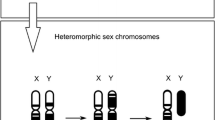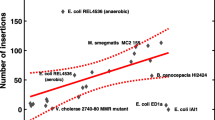Abstract
The review analyzed the validity of using unstable alleles of Drosophila melanogaster genes to assess the rate of movement of mobile genetic elements by the frequency of phenotype change. Several examples show that the instability of alleles with introduced transposons is determined to a greater degree by recombination between them than by the true movement of transposons with the participation of transposase.
Similar content being viewed by others
REFERENCES
Nuzhdin, S.V., Pasyukova, E.G., and Mackay, T.F., Accumulation of transposable elements in laboratory lines of Drosophila melanogaster, Genetica, 1997, vol. 100, nos. 1—3, pp. 167–175.
Maside, X., Assimacopoulos, S., and Charlesworth, B., Rates of movement of transposable elements on the second chromosome of Drosophila melanogaster, Genet. Res., 2000, vol. 75, no. 3, pp. 275–284. https://doi.org/10.1017/s0016672399004474
Maside, X., Assimacopoulos, S., and Charlesworth, B., Genome-wide estimates of transposable element insertion and deletion rates in Drosophila melanogaster, Genome Biol. Evol., 2017, vol. 9, no. 5, pp. 1329–1340. https://doi.org/10.1093/gbe/evx050
Eggleston, W.B., Johnson-Schlitz, D.M., and Engels, W.R., P-M hybrid dysgenesis does not mobilize other transposable element families in D. melanogaster, Nature, 1988, vol. 331, no. 6154, pp. 368–370. https://doi.org/10.1038/331368a0
Eggleston, W.B., Rim, N.R., and Lim, J.K., Molecular characterization of hobo-mediated inversions in Drosophila melanogaster, Genetics, 1996, vol. 144, no. 2, pp. 647–656.
Khurana, J.S., Wang, J., Xu, J., et al., Adaptation to P element transposon invasion in Drosophila melanogaster, Cell, 2011, vol. 147, no. 7, pp. 1551–1563. https://doi.org/10.1016/j.cell.2011.11.042
Novak, P., Neumann, P., and Macas, J., Graph-based clustering and characterization of repetitive sequences in next-generation sequencing data, BMC Bioinf., 2010, vol. 11, p. 378. https://doi.org/10.1186/1471-2105-11-378
Goubert, C., Modolo, L., Vieira, C., et al., De novo assembly and annotation of the Asian tiger mosquito (Aedes albopictus) repeatome with dnaPipeTE from raw genomic reads and comparative analysis with the yellow fever mosquito (Aedes aegypti), Genome Biol. Evol., 2015, vol. 7, pp. 1192–1205. https://doi.org/10.1093/gbe/evv050
Mohamed, M., Dang, N.T., Ogyama, Y., et al., A transposon story: from TE content to TE dynamic invasion of Drosophila genomes using the single-molecule sequencing technology from Oxford nanopore, Cells, 2020, vol. 9, no. 8. E1776. https://doi.org/10.3390/cells9081776
Treiber, C.D. and Waddell, S., Resolving the prevalence of somatic transposition in Drosophila, Elife, 2017, vol. 6. e28297. https://doi.org/10.7554/eLife.28297
Roiha, H., Rubin, G.M., and O’Hare, K., P element insertions and rearrangements at the singed locus of Drosophila melanogaster, Genetics, 1988, vol. 119, pp. 73–83.
Lim, J.K. and Simmons, M.J., Gross chromosome rearrangements mediated by transposable elements in Drosophila melanogaster, BioEssays, 1994, vol. 16, no. 4, pp. 269–275. https://doi.org/10.1002/bies.950160410
Dolgin, E.S. and Charlesworth, B., The effects of recombination rate on the distribution and abundance of transposable elements, Genetics, 2008, vol. 178, no. 4, pp. 2169–2177. https://doi.org/10.1534/genetics.107.082743
Paterson, J., Simmons, M.J., and O’Hare, K., Transcription of the singed-weak mutation of Drosophila melanogaster: elimination of P-element sequences by RNA splicing and repression of singed transcription in a P genetic background, Mol. Genet. Genomics, 2007, vol. 278, pp. 53–64. https://doi.org/10.1007/s00438-007-0227-z123
Ota, R. and Kobayashi, S., Myc plays an important role in Drosophila P-M hybrid dysgenesis to eliminate germline cells with genetic damage, Commun. Biol., 2020, vol. 3, p. 185. https://doi.org/10.1038/s42003-020-0923-3
McClintock, B., The origin and behavior of mutable loci in maize, Proc. Natl. Acad. Sci. U.S.A., 1950, vol. 36, no. 6, pp. 344–355. https://doi.org/10.1073/pnas.36.6.344
McClintock, B., Chromosome organization and genic expression, Cold Spring Harbor Symp. Quant. Biol., 1951, vol. 16, pp. 13–47.
Kunze, R. and Weil, C.F., The hAT and CACTA superfamilies of plant transposons, in Mobile DNA II, Craig, N.L., Craigie, R., Gellert, M., et al., Eds., Washington: ASM, 2002, pp. 565–610.
McBlane, J.F., van Gent, D.C., Ramsden, D.A., et al., Cleavage at a V(D)J recombination signal requires only RAG1 and RAG2 proteins and occurs in two steps, Cell, 1995, vol. 83, pp. 387–395. https://doi.org/10.1016/0092-8674(95)90116-7
Coupland, G., Plum, C., Chatterjee, S., et al., Sequences near the termini are required for transposition of the maize transposon Ac in transgenic tobacco plants, Proc. Natl. Acad. Sci. U.S.A., 1989, vol. 86, pp. 9385–9388. https://doi.org/10.1073/pnas.86.23.9385
Vollbrecht, E., Duvick, J., Schares, J.P., et al., Genome-wide distribution of transposed dissociation elements in maize plant cell, Plant Cell, 2010, vol. 22, no. 6, pp. 1667–1685. https://doi.org/10.1105/tpc.109.073452
Weil, C.F. and Wessler, S.R., Molecular evidence that chromosome breakage by Ds elements is caused by aberrant transposition, Plant Cell, 2010, vol. 22, no. 6, pp. 1667–1685. https://doi.org/10.1105/tpc.109.073452
Fujimoto, S., Matsunaga, S., and Murata, M., Mapping of T-DNA and Ac/Ds by TAIL-PCR to analyze chromosomal rearrangements, Methods Mol. Biol., 2016, vol. 1469, pp. 207–216. https://doi.org/10.1007/978-1-4939-4931-1_17
Bai, L. and Brutnell, T.P., The activator/dissociation transposable elements comprise a two-component gene regulatory switch that controls endogenous gene expression in maize, Genetics, 2011, vol. 187, no. 3, pp. 749–759. https://doi.org/10.1534/genetics.110.124149
Xuan, Y.H., Peterson, T., and Han, C.D., Generation and analysis of transposon Ac/Ds-induced chromosomal rearrangements in rice plants, Methods Mol. Biol., 2016, vol. 1469, pp. 49–61. https://doi.org/10.1007/978-1-4939-4931-1_4
Lazarow, K., Doll, M.L., and Kunze, R., Molecular biology of maize Ac/Ds elements: an overview, Methods Mol. Biol., 2013, vol. 1057, pp. 59–82. https://doi.org/10.1007/978-1-62703-568-2_5
Mielich, K., Shtifman-Segal, E., Golz, J.C., et al., Maize transposable elements Ac/Ds as insertion mutagenesis tools in Candida albicans, Genes, Genomes, Genet., (Bethesda), 2018, vol. 8, no. 4, pp. 1139–1145. https://doi.org/10.1534/g3.117.300388
Puchta, H. and Fauser, F., Gene targeting in plants: 25 years later, Int. J. Dev. Biol., 2013, vol. 57, nos. 6–8, pp. 629–637. https://doi.org/10.1387/ijdb.130194hp
Zakharov, I.K., Ivannikov, A.V., Skibitskii, E.S., et al., Genetic properties of alleles from genes on the X-chromosome isolated from natural Drosophila melanogaster populations during mutational bursts, Dokl Akad Nauk, 1995, vol. 341, no. 1, pp. 126–129.
Gracheva, E.M., Zakharov, I.K., Voloshina, M.A., et al., Mutation bursts of the yellow gene in a natural Drosophila melanogaster population are connected with insertion of the hobo transposon, Russ. J. Genet., 1998, vol. 34, no. 4, pp. 364–370.
Zakharenko, L.P., Zakharov, I.K., Romanova, O.A., et al., “Mode for mutation” in the natural population of Drosophila melanogaster from Uman is caused by distribution of a hobo-induced inversion in the regulatory region of the yellow gene, Russ. J. Genet., 2000, vol. 30, no. 6, pp. 603–610.
Zakharenko, L.P., Zakharov, I.K., Voloshina, M.A., et al., The reason for the preservation of high instability at the yellow gene in Drosophila melanogaster strains isolated from the natural population of Uman’ during the “mode for mutation,” Russ. J. Genet., 2004, vol. 40, no. 3, pp. 239–243. https://doi.org/10.1023/B:RUGE.0000021622.09855.49
Zakharenko, L.P., Kovalenko, L.V., Mai, S., and Zakharov, I.K., Persistent locus-specific instability of yellow2-717 and NotchUc-1 in Drosophila melanogaster coincides with hobo multiplication, Cell Tissue Biol., 2007, vol. 1, no. 6, pp. 497–502. https://doi.org/10.1134/S1990519X07060053
Arensburger, P., Hice, R.H., Zhou, L., et al., Phylogenetic and functional characterization of the hAT transposon superfamily genetics, Genetics, 2011, vol. 188, no. 1, pp. 45–57. https://doi.org/10.1534/genetics.111.126813
Hemmer, L.W., Dias, G.B., Smith, B., et al., Hybrid dysgenesis in Drosophila virilis results in clusters of mitotic recombination and loss-of-heterozygosity but leaves meiotic recombination unaltered, Mob. DNA, 2020, vol. 11, p. 10. https://doi.org/10.1186/s13100-020-0205-0
Daniels, S.B. and Chovnick, A., P element transposition in Drosophila melanogaster: an analysis of sister-chromatid pairs and the formation of intragenic secondary insertions during meiosis, Genetics, 1993, vol. 133, no. 3, pp. 623–636.
O’Hare, K., Tam, J.L., Lim, J.K., et al., Rearrangements at a hobo element inserted into the first intron of the singed gene in the unstable sn49 system of Drosophila melanogaster, Mol. Gen. Genet., 1998, vol. 257, no. 4, pp. 452–460. https://doi.org/10.1007/s004380050669
Nitasaka, E. and Yamazaki, T., Excision of one of two defective P elements as the cause of alternate mutational events (sn + and sn e) of the singed bristle allele sn w in Drosophila melanogaster, Jpn. J. Genet., 1988, vol. 63, no. 4, pp. 303–312. https://doi.org/10.1266/jjg.63.303
Ortori, C.A., Chambers, D., and Brookfield, J.F., The molecular basis of instability of the singed (very weak) mutation in Drosophila melanogaster, Genet. Res., 1994, vol. 63, no. 1, pp. 19–26. https://doi.org/10.1017/s0016672300032043
Engels, W.R. and Preston, C.R., Formation of chromosome rearrangements by P factors in Drosophila, Genetics, 1984, vol. 107, no. 4, pp. 657–678.
ACKNOWLEDGMENTS
The author thanks I.K. Zakharov for valuable comments.
Funding
The work was supported by the budget project no. 0259-2021-0016.
Author information
Authors and Affiliations
Corresponding author
Ethics declarations
The author declares no conflict of interests. This article does not contain any studies involving animals or human participants performed by the author.
Additional information
Translated by D. Novikova
Rights and permissions
About this article
Cite this article
Zakharenko, L.P. Phenotypically Unstable Mutations as Markers of Chromosomal Rearrangements Involving DNA Transposons. Russ J Genet 57, 1253–1257 (2021). https://doi.org/10.1134/S1022795421110156
Received:
Revised:
Accepted:
Published:
Issue Date:
DOI: https://doi.org/10.1134/S1022795421110156




